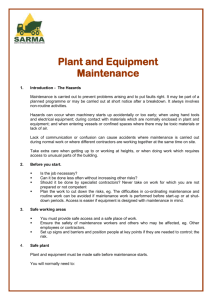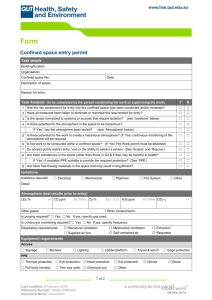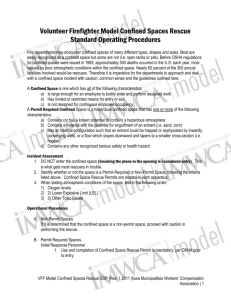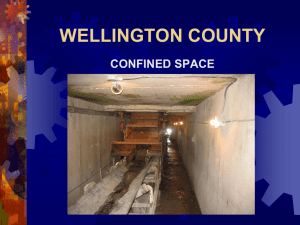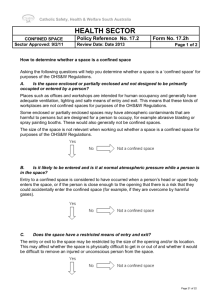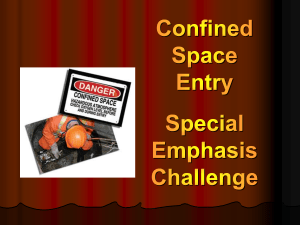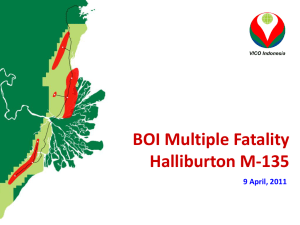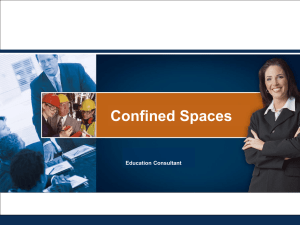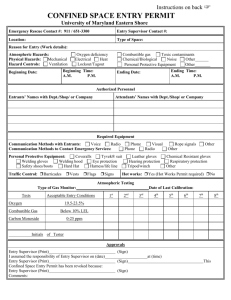MODEL ENTRY PROCEDURE FOR CONFINED SPACES 1.0
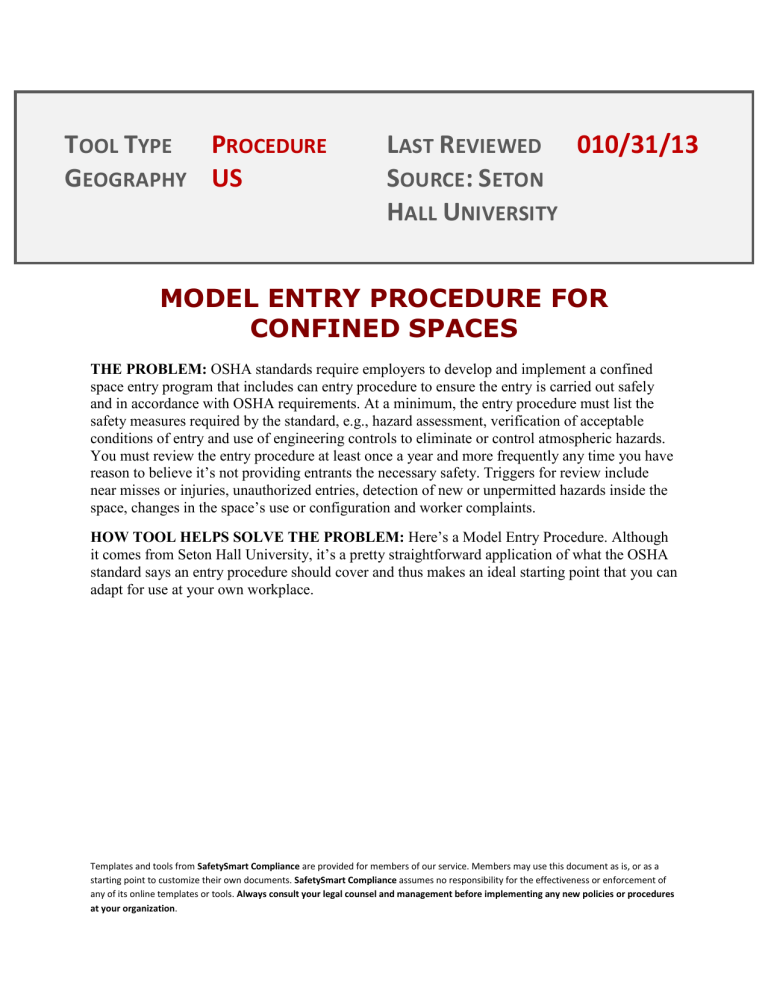
T
OOL
T
YPE
P
ROCEDURE
L
AST
R
EVIEWED
010/31/13
G
EOGRAPHY
US S
OURCE
: S
ETON
H
ALL
U
NIVERSITY
MODEL ENTRY PROCEDURE FOR
CONFINED SPACES
THE PROBLEM: OSHA standards require employers to develop and implement a confined space entry program that includes can entry procedure to ensure the entry is carried out safely and in accordance with OSHA requirements. At a minimum, the entry procedure must list the safety measures required by the standard, e.g., hazard assessment, verification of acceptable conditions of entry and use of engineering controls to eliminate or control atmospheric hazards.
You must review the entry procedure at least once a year and more frequently any time you have reason to believe it’s not providing entrants the necessary safety. Triggers for review include near misses or injuries, unauthorized entries, detection of new or unpermitted hazards inside the space, changes in the space’s use or configuration and worker complaints.
HOW TOOL HELPS SOLVE THE PROBLEM: Here’s a Model Entry Procedure. Although it comes from Seton Hall University, it’s a pretty straightforward application of what the OSHA standard says an entry procedure should cover and thus makes an ideal starting point that you can adapt for use at your own workplace.
Templates and tools from SafetySmart Compliance are provided for members of our service. Members may use this document as is, or as a starting point to customize their own documents. SafetySmart Compliance assumes no responsibility for the effectiveness or enforcement of any of its online templates or tools. Always consult your legal counsel and management before implementing any new policies or procedures
at your organization.
MODEL ENTRY PROCEDURE FOR
CONFINED SPACES
1.0 Purpose
This Confined Space Entry Procedure will assure that proper precautions are taken when employees or contractor personnel must enter a confined space located on the premises of ABC
Company worksites to perform activities such as inspecting, cleaning, testing and repairing. By following this procedure, such hazards as oxygen deficiency, hazardous materials, material engulfment, power-driven equipment, electrical shock, and difficulty in escaping will be eliminated or properly controlled and compliance with OSHA requirements shall be ensured.
2.0 Scope
This procedure establishes minimum requirements that must be met or exceeded, and applies to activities performed by both site employees and contractor employees.
3.0 Definitions
Acceptable Entry : The conditions that must exist in a confined space to allow entry and to ensure that personnel involved with an entry can safely enter into and work within the space.
Atmosphere Supplying Respirator : Either a full-face piece self-contained breathing apparatus
(SCBA) or airline full-face piece respirator connected to a Grade D or equivalent breathable compressed air source. Airline respirators must be connected to a 5-minute escape bottle.
Atmospheric Testing Confined Space (ATCS) : A confined space that requires a permit and which contains or has a potential to contain a hazardous atmosphere, as defined below.
Confined Space: A space that:
1.
Is large enough and so configured that an employee can bodily enter and perform assigned work; and
2.
Has limited or restricted means for entry/exit or rescue (for example tanks, vessels, silos, storage bins, hoppers, utility vaults, and pits are spaces that may have limited means of entry/exit or rescue); and
3.
Is not designed for continuous employee occupancy.
Templates and tools from SafetySmart Compliance are provided for members of our service. Members may use this document as is, or as a starting point to customize their own documents. SafetySmart Compliance assumes no responsibility for the effectiveness or enforcement of any of its online templates or tools. Always consult your legal counsel and management before implementing any new policies or procedures
at your organization.
Engulfment : The surrounding and effective capture of a person by a liquid or finely divided
(flow able) solid substance that can be aspirated to cause death by filling or plugging the respiratory system or that can exert enough force on the body to cause death by strangulation, constriction, or crushing.
Entry : The action by which a person passes through an opening into a confined space. Entry includes ensuing work activities in that space and is considered to have occurred as soon as the entrant's face breaks the plane of an opening into the space.
Ground Fault Circuit Interrupter (GFCI) : A fast-acting circuit breaker that is sensitive to very low levels of current leakage to ground. It will trip and prevent serious injury.
Hazardous Atmosphere : An atmosphere that may expose employees to the risk of death, incapacitation, impairment of ability to self rescue (that is, escape unaided from a confined space), injury, or acute illness from one or more of the following causes:
1.
Flammable gas, vapor, or mist in excess of zero percent of its lower flammable limit
(LFL);
2.
Airborne combustible dust at a concentration that equals or exceeds its LFL; (As a rule of thumb, this is a concentration that obscures vision at a distance of 5 feet or less)
3.
Atmospheric oxygen concentration below 19.5 percent or above 23.5 percent;
4.
Atmospheric concentration of any substance, which could result in employee exposure in excess of its occupational exposure limit (e.g., TLV {threshold limit value}, PEL
{permissible exposure limit})
5.
Any other atmospheric condition that is immediately dangerous to life or health.
Hot Work : Any work involving electric or gas welding, cutting, brazing, burning or similar flame or spark producing operations. This includes, but is not limited to, acetylene torches, arc welding equipment, portable grinders, propane torches, explosion actuated tools, etc.
IDLH (Immediately Dangerous to Life and Health) : Any condition that poses an immediate or delayed threat to life or that would cause irreversible adverse health effects or that would interfere with an individual's ability to escape unaided from a confined space.
Isolation of Hazardous Materials : The process in which flammable, injurious, or incapacitating substances which require piping systems connected to confined spaces to be disconnected, blanked, or double blocked and bled by valve arrangement. Lines containing water, etcetera, at
120° F or less do not require the additional isolation.
Non-Atmospheric Testing Confined Space (NATCS) : A confined space which requires a permit that does not contain or, have the potential to contain a hazardous atmosphere. However, the space does have one or more of the following characteristics:
1.
Contains a material that has the potential for engulfing an entrant;
Templates and tools from SafetySmart Compliance are provided for members of our service. Members may use this document as is, or as a starting point to customize their own documents. SafetySmart Compliance assumes no responsibility for the effectiveness or enforcement of any of its online templates or tools. Always consult your legal counsel and management before implementing any new policies or procedures
at your organization.
2.
Has an internal configuration such that an entrant could be trapped by inwardly converging walls or by a floor, which slopes downward and tapers to a smaller crosssection;
3.
Contains any other recognized serious safety or health hazard;
4.
Has limited or restricted means of entry/exit for rescue capability.
Personal Alert Safety System (PASS) : A safety device, which will detect lack of motion of a worker and automatically emit an audio warning signal. The PASS shall meet the NFPA 1982 standard.
Rescue : An established emergency response procedure whereby both the rescue personnel and all necessary rescue equipment are available at the incident scene in a timely manner so that rescue can commence within 5 minutes of the start of an emergency.
Retrieval System : The equipment including a retrieval line, full body harness, wristlets (if appropriate), and a lifting device or anchor used for non-entry rescue of persons from confined spaces.
Zero Mechanical State (ZMS) : A condition in which all potentially hazardous energy in equipment is neutralized to provide maximum protection against unexpected mechanical movement.
4.0 Procedure
4.1 Responsibilities
4.1.1 Authorized Entrant An employee who is authorized by the employer to enter a confined space. Entrants shall:
1.
Have received training on the location confined space entry procedure during the last 2 years.
2.
Know the hazards or potential hazards faced during entry and the symptoms and consequences of any related exposures.
3.
Properly use equipment required by entry.
4.
Keep entry sign in/out log current regarding his entry status.
5.
Alert the lookout to hazardous conditions in the space.
6.
Exit from the confined space when an evacuation alarm or order is given or when a hazardous condition is detected in the space.
4.1.2 Contractor Entries - When arrangements have been made to have contractor employees perform work that involves confined space entry, locations shall:
1.
Assign a Contractor Coordinator responsible to insure the contractor understands and follows this procedure and all aspects for Contractors on Premises.
Templates and tools from SafetySmart Compliance are provided for members of our service. Members may use this document as is, or as a starting point to customize their own documents. SafetySmart Compliance assumes no responsibility for the effectiveness or enforcement of any of its online templates or tools. Always consult your legal counsel and management before implementing any new policies or procedures
at your organization.
2.
Inform contractors that confined space entries are permitted only through compliance with a permit space program that meets or exceeds this procedure.
3.
Apprise the contractor of the space hazards
4.
Inform contractors of precautions, which have been implemented for the protection of employees in or near the specified spaces.
5.
Coordinate entry operations with the contractor when both contractors and employees are working simultaneously as authorized entrants in a confined space, so that employees of one employer do not endanger the employees of any other employer.
6.
Debrief the contractor at the conclusion of the entry operations to discuss problems encountered.
4.1.3 Entry Supervisor - The person (such as foreman, team leader, or authorized employee) responsible for: a) determining if acceptable entry conditions are present at a confined space where entry is planned; b) authorizing entry and overseeing entry operations; and c) terminating entry. The duties of entry supervisor may be passed to another qualified person during the course of an entry operation. Entry Supervisors shall:
1.
Know the hazards faced during entry and the symptoms and consequences of exposures.
2.
Verify by checking and/or completing the entry permit that all required tests have been conducted and all procedures and equipment are in place before endorsing the permit and allowing entry to begin.
3.
Verify that rescue services are available and that the means for summoning them are operable; and ensure the lookout is aware of which rescue service will be used.
4.
Terminate the entry and cancel the permit when the entry operations covered by the entry permit have been completed or when a condition not allowed under the entry permit arises in or near the confined space.
5.
Remove unauthorized individuals who enter or who attempt to enter the permit space during operations.
6.
Determine that entry operations remain consistent with the terms of the entry permit and that acceptable entry conditions are maintained.
4.1.4 Lookout - An individual stationed outside a confined space who monitors the authorized entrants. Lookouts shall:
1.
Know the hazards faced during entry and the symptoms and consequences of exposures to authorized entrants.
2.
Understand all requirements of the Lookout Section of the entry permit and verify by signing the permit.
3.
Ensure that all individuals who enter or leave the confined space are continually accounted for and have signed in or out.
4.
Remain outside the confined space during entry operations until relieved by another qualified lookout.
Templates and tools from SafetySmart Compliance are provided for members of our service. Members may use this document as is, or as a starting point to customize their own documents. SafetySmart Compliance assumes no responsibility for the effectiveness or enforcement of any of its online templates or tools. Always consult your legal counsel and management before implementing any new policies or procedures
at your organization.
5.
Continuously monitor activities inside and outside the space to determine if it is safe for entrants to remain in the space.
6.
Order authorized entrants to evacuate the confined space immediately when a hazard arises.
7.
Summon rescue services when authorized entrants may need assistance to escape from confined space hazards.
8.
Keep unauthorized entrants from entering the confined spaces.
9.
Perform non-entries or entry rescues (if required by location rescue procedures and properly trained), however, entry rescues cannot be performed until another lookout is posted.
10.
Perform no other duties that might interfere with the primary duty of monitoring and protecting the authorized entrants.
4.1.5 Rescue and Emergency Service - The personnel designated to rescue employees from confined spaces. A minimum of two members of the rescue service shall:
1.
Be provided with and trained in the use of personal protective equipment and rescue equipment necessary for making rescues from confined spaces.
2.
Be trained to perform the assigned rescue duties.
3.
Receive the same training required of authorized entrants under 5.1.1 of this section.
4.
Practice simulated rescue operations annually from actual or representative confined spaces.
5.
Be trained and certified in basic first aid and CPR (cardiopulmonary resuscitation) and be trained in the bloodborne pathogens procedure.
6.
Ensure that a lookout is posted outside the space prior to entry.
Note : For those sites where personnel enter atmospheric testing confined spaces (ATCS), there must be an on-site rescue service trained to comply with 1-6 above.
For those sites where personnel only enter non-atmospheric testing confined spaces (NATCS), an outside agency may be used to provide rescue services. However, the outside rescuers must be trained to comply with 1 - 6 per above.
4.1.6 Test Equipment Operator - A person who performs atmospheric testing to evaluate potential airborne hazards in an ATCS space. Test Equipment Operators shall:
1.
Know the operation and limitations of the monitoring instruments, including the required field checks (checking the instrument for proper response in the field) specified by the instrument manufacturer.
2.
Know actual testing practices and testing requirements specified by this procedure.
3.
Enter the test results on the confined space entry permit along with signature.
4.
Inform the entry supervisor whenever atmospheric testing indicates a hazardous atmosphere.
Templates and tools from SafetySmart Compliance are provided for members of our service. Members may use this document as is, or as a starting point to customize their own documents. SafetySmart Compliance assumes no responsibility for the effectiveness or enforcement of any of its online templates or tools. Always consult your legal counsel and management before implementing any new policies or procedures
at your organization.
4.2 Confined Space Evaluation and Identification
4.2.1
Each location shall evaluate its workplace to determine if any spaces are confined spaces.
These spaces shall be evaluated for potential hazards as defined in section 3.
4.2.2
If the decision is made that a confined space does not require atmospheric testing, this decision shall be approved by the facility manager and supported by historical atmospheric testing data. These spaces shall be treated as Non-atmospheric testing confined spaces (NATCS) as defined in section 3.
4.2.3
The location shall post danger signs at each entrance to Confined Spaces. A sign reading
" Danger-Permit-Required-Confined Space. Do Not Enter " or other similar language satisfies the requirement for a sign.
4.3 Permit Entry Procedure for Atmospheric Testing Confined Spaces
4.3.1 Brief All Authorized Entrants
Prior to entry, the entry supervisor must ensure that the authorized entrants are fully informed of hazardous materials or conditions they are likely to encounter by conducting a safety preparation briefing.
4.3.2 Make Safe for Entry
4.3.2.1. Permit System
1.
Before entering a confined space, the space must be made safe. A detailed "Confined
Space Entry Permit and Checklist" must be completed, signed by the appropriate entry supervisor, test equipment operator and lookout person, and posted at all entry points being used to enter the space.
2.
The initial confined space entry permit will be valid for the specified duration of the job. The entry permit shall be reviewed and re-validated upon change of entry supervisor.
4.3.2.2 Control of Internal Hazards
Place the confined space in a zero mechanical state condition and isolate the space from unexpected ingress of materials in accordance with the ABC Company Lockout Tagout
Procedure.
4.3.2.3 Control of External Hazards
Steps shall be taken to ensure that all precautions necessary to protect authorized entrants from external hazards are provided. This includes: barriers, exhaust from vehicles, releases from
Templates and tools from SafetySmart Compliance are provided for members of our service. Members may use this document as is, or as a starting point to customize their own documents. SafetySmart Compliance assumes no responsibility for the effectiveness or enforcement of any of its online templates or tools. Always consult your legal counsel and management before implementing any new policies or procedures
at your organization.
adjacent processes, or materials brought into the confined space for required work.
4.3.2.4 Cleaning/Purging
All confined spaces shall be emptied, flushed, or otherwise purged of hazardous materials.
Acceptable techniques can include flushing with water or steam and/or cleaning with any acceptable alternative practice, depending on the nature of the material contained in the confined space. If steam is used for cleaning, the space must be cooled before entering.
4.3.2.5 Ventilation
The confined space shall be thoroughly and continuously ventilated by use of fans, blowers, or any other method, which will ensure an adequate continuous movement of uncontaminated air through the confined space. Care should be taken to ensure that there is sufficient air circulation to eliminate pockets of contaminated air. Natural ventilation may satisfy this requirement if the airflow is adequate.
4.3.3 Test Atmosphere for Acceptable Entry Conditions
4.3.3.1
Test equipment accuracy shall be verified (field checked) and bench top calibrations performed and documented in accordance with manufacturer specifications.
4.3.3.2
The Test Equipment Operator will test the atmosphere in the confined space to determine if acceptable entry conditions exist before entry is authorized to begin. This may be effected from a manhole, provided the potential work areas and entry point(s) can be reached by a remote sensor. Otherwise, the test equipment operator must enter the space using an atmospheresupplying respirator with retrieval system to conduct testing in all potential work areas of the space. A lookout must be posted during this testing.
4.3.3.3
ATCS spaces shall be tested for the following acceptable entry atmospheric conditions in the order specified below:
1.
Oxygen concentration between 19.5% and 23.5%
2.
Flammable vapors, gas, or mist at 0% of its lower flammable limit (LFL). Continuous monitoring must be used where there is potential for liberation of flammable or toxic materials. In situations where gases and vapors are liberated after initial zero readings, evacuation must take place if a measurement of 10% LFL is observed.
3.
Appropriate toxic air contaminant concentration below established TLV's
4.
Airborne combustible dust (e.g. wood dust, coal dust) less than its LFL; as a rule of thumb this is a concentration that obscures vision at a distance of 5 feet or less.
4.3.3.4
Continuous monitoring must be performed where there is a likelihood for a hazardous
Templates and tools from SafetySmart Compliance are provided for members of our service. Members may use this document as is, or as a starting point to customize their own documents. SafetySmart Compliance assumes no responsibility for the effectiveness or enforcement of any of its online templates or tools. Always consult your legal counsel and management before implementing any new policies or procedures
at your organization.
atmosphere to be generated during entry to the space. Continuous monitoring for oxygen concentrations or toxic atmospheres is not required if the employees working inside the confined space are wearing atmosphere supplying respirator.
4.3.3.5
To ensure that the atmospheric conditions within the space remain safe during an extended entry, follow-up tests in the space should be made as often as determined necessary by the entry supervisor. At a minimum, the confined space must be re-evaluated at shift changes. The retesting shall be documented on the entry permit. Continuous monitoring can satisfy this requirement.
4.3.3.6
If the confined space remains unattended for an extended period of time (i.e.: approximately one hour); re-entry is not permitted until atmospheric re-testing of the space is performed.
4.3.4 Entry
4.3.4.1
The entry supervisor shall verify the completion of actions required in sections 4.1 -
4.3 of this section by signing the confined space entry permit. Authorized entrants can now enter the space.
4.3.4.2
When authorized entrants are inside a confined space, they must be within sight of the lookout stationed outside the space. If line of sight cannot be maintained, two-way radio or voice communications between the lookout and the entrants in the confined space in addition to the use of a personal alert safety system (PASS) will be required. One radio and one PASS per group of employees inside the space are acceptable as long as the entrants can maintain line of sight with each other.
4.3.5 Ending of Entry
4.3.5.1
Once the work has been completed and all authorized entrants are known to be out of the confined space, the permits shall be removed and canceled by the entry supervisor in charge of the space and forwarded to a designated department/person for review.
4.3.5.2
The entry supervisor shall ensure that the confined space is returned to a safe condition prior to cancellation of the entry permit.
4.3.5.3
Canceled entry permits shall be filed and retained for one year to facilitate the annual audit of the confined space entry program. If a location performs a documented, self-audit of their program more frequently than once per year the retention time for canceled permits may be reduced accordingly.
4.4 Permit Entry Procedure for Non-atmospheric Testing Confined Spaces
4.4.1
Safe work practices shall also be applied to entry into non-atmospheric testing confined
Templates and tools from SafetySmart Compliance are provided for members of our service. Members may use this document as is, or as a starting point to customize their own documents. SafetySmart Compliance assumes no responsibility for the effectiveness or enforcement of any of its online templates or tools. Always consult your legal counsel and management before implementing any new policies or procedures
at your organization.
spaces (NATCS). These practices include those required by Section 4.0 except Section 4.3.3.
4.4.2
If the location arranges to have an outside rescue service perform NATCS rescues, the location shall:
1.
Inform the rescue service of the space hazards.
2.
Provide the rescue service with access to all spaces so that the rescue service can develop appropriate rescue plans and practice rescue operations.
4.5 Work Practices Inside a Confined Space
4.5.1 Electrical Equipment
4.5.1.1
Portable electric equipment and lighting used in confined spaces shall be operated at 18 volts or less.
4.5.1.2
When a step-down transformer is used, the transformer must be left outside the space.
4.5.1.3
Lighting must be explosion proof if the potential for a combustible atmosphere is present.
4.5.2 Hot Work
4.5.2.1
Hot work shall be performed in accordance with the ABC Company Hot Work
Procedure.
4.6 PPE and Rescue Equipment
4.6.1 PPE
4.6.1.1
PPE such as goggles, respirators, boots, hardhats, gloves, and protective clothing must be worn when the entry supervisor determines them necessary.
4.6.1.2
If tests indicate that the confined space contains a hazardous atmosphere, employees must not enter unless authorized by their entry supervisor and then only if wearing appropriate respiratory protection in accordance with the ABC Company Respiratory Protection Program.
4.6.2 Retrieval System
4.6.2.1
Each authorized entrant shall wear a full body harness with a retrieval line attached except that:
1.
The retrieval line does not have to be attached to the entrant if it would increase the overall risk of entry or would not contribute to the rescue of the entrant. However,
Templates and tools from SafetySmart Compliance are provided for members of our service. Members may use this document as is, or as a starting point to customize their own documents. SafetySmart Compliance assumes no responsibility for the effectiveness or enforcement of any of its online templates or tools. Always consult your legal counsel and management before implementing any new policies or procedures
at your organization.
precautions must be taken so that the task can be performed as safely as without the retrieval line. These exceptions must be approved by chief engineer, safety professional or industrial hygienist and appropriately documented.
2.
Wristlets can be used if the location determines the use of a harness is infeasible or creates a greater hazard.
4.6.2.2
A mechanical device shall be readily available to retrieve personnel from vertical-type confined spaces more than 5 feet deep.
4.6.2.3
The end of the retrieval line which is outside the confined space shall be attached to a mechanical device or fixed point in such a manner that rescue can begin as soon as the rescuer becomes aware that rescue is necessary.
4.6.3 Rescue Equipment
5.6.3.1
All appropriate rescue equipment such as harnesses, retrieval lines, stretchers, a mechanical means for removing an injured person from a confined space, etc. must be readily available for emergency use by the rescue team.
4.6.3.2
When entrants inside a confined space might be potentially exposed to a hazardous atmosphere, an atmospheric supplying respirator must be readily available for emergency use by the rescue team. As a minimum, this requirement shall be followed for entry into all ATCS spaces.
5.0 Training
5.1
ABC Company shall provide training so that all personnel whose work is regulated by
Section 4.0 of this procedure acquire the understanding, knowledge, and skills necessary for the safe performance of their assigned duties. The training shall be provided initially upon assignment and afterwards at least once every two years.
5.2
The training shall establish employee proficiency in the duties required by this procedure and shall introduce new or revised procedures, as necessary, for compliance with this procedure.
5.3
Locations shall certify that the required training has been accomplished through documentation including the following information:
1.
Date of the training
2.
Name(s) and signature of the instructor(s)
3.
Outline of the training
4.
Signatures of the employees to whom the training was given.
Templates and tools from SafetySmart Compliance are provided for members of our service. Members may use this document as is, or as a starting point to customize their own documents. SafetySmart Compliance assumes no responsibility for the effectiveness or enforcement of any of its online templates or tools. Always consult your legal counsel and management before implementing any new policies or procedures
at your organization.
6.0 Audits
6.1
ABC Company shall annually perform a self-audit of the entire confined space entry procedure including a review of the canceled permits. Based on the results of this audit, appropriate program changes must be initiated and documented.
6.2
As part of the annual audit process, a field review of one complete confined space entry must be conducted for both site and contractor employee entries. If entries are less frequent than once per year, then every entry must be audited.
Source: http://www.shu.edu/offices/policies-procedures/facilities-engineering-entryprocedure.cfm
.
Templates and tools from SafetySmart Compliance are provided for members of our service. Members may use this document as is, or as a starting point to customize their own documents. SafetySmart Compliance assumes no responsibility for the effectiveness or enforcement of any of its online templates or tools. Always consult your legal counsel and management before implementing any new policies or procedures
at your organization.
